Crane, barge may be used to tow whale graveyard to sea
Six stranded pilot whales have been released to sea with hope for another 12 to 20 with rescue operations continuing at Macquarie Harbour at Strahan. LATEST FROM THE SCENE >>
The Launceston News
Don't miss out on the headlines from The Launceston News. Followed categories will be added to My News.
- Four whales euthanised as rescuers try to save 20 more
- More whales saved as rescuers hold hopes for another 20
UPDATE, 3.59PM:
A NUMBER of the ten whales that rebeached themselves overnight have died as efforts continue to free the 12 to 20 whales with the greatest chance of survival.
Marine Conservation Program wildlife biologist Dr Kris has said volunteer rescuer numbers remained steady at about 90 to 100 people at a time.
He said the volunteers’ support had been “fantastic” so far.
Premier Peter Gutwein thanked the responders “on behalf of all Tasmanians” for their help at Macquarie Harbour.
“Every whale saved is an incredible outcome given the complicated conditions and is testament to the tireless and skilful work that the response team are undertaking,” he said.
Mr Gutwein extended his thanks to the Strahan community who have helped feed, accommodate and support the volunteers.
“Our thoughts are with the response team who have another few tough few days ahead.”
UPDATE, 2.45PM:
SIX stranded pilot whales had been released to sea on Friday by 1pm with hope for another 12-20 with rescue operations continuing at Macquarie Harbour at Strahan.
The total of those returned to sea now stands at 94, however 10 whales previously released became stranded again overnight.
There are believed to be about 350 whale carcasses inside the harbour and unknown number on outer beaches.
One whale was euthanised on Friday morning for welfare reasons with five now having been put down.
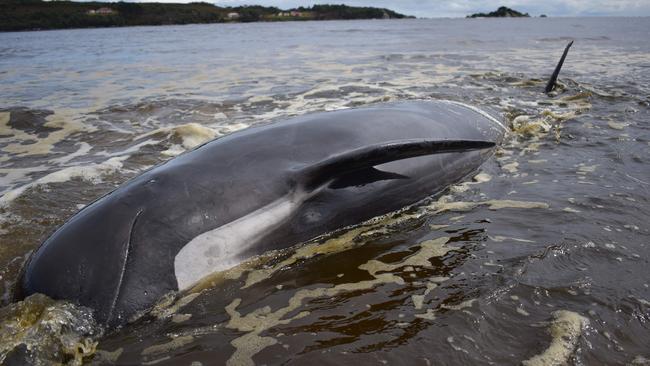
Parks and Wildlife regional manager Nic Deka said crews would continue to do what they could for the living whales.
“We’re hopeful we will release a few more from the sandbar out to sea, but we’ll have to see how it goes as the day goes on,” he said.
Mr Deka said the collection of whale carcasses continued on Friday at Betsy’s Bay and Fraser Flats where about 200 whales were found dead on Wednesday.
“We’ve also been segregating live animals from the dead animals to assist with the collection.
“Today we’ll also be trialling a technique to enable disposal at sea.”
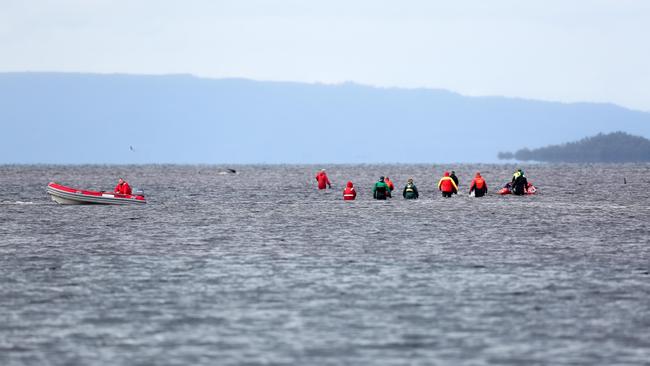
A barge from Devonport carrying a crane is being considered to load carcasses on-board and take them to sea, however that option is being reassessed after “excellent discussions with” local aquaculture companies on Tuesday night.
“We came up with some other options and we are going to be looking at trialling those.”
Smaller boats using long ropes with a series of loops at the end to tow small groups of whales out to sea is currently thought to be the “best method”.
“The aim is to remove the carcasses from Macquarie Harbour as quickly as possible — ideally within four or five days.”
Marine Conservation wildlife biologist Dr Kris Carlyon the whales that become stuck again overnight were being assessed with options for “refloating those animals” being considered to “give them another chance”.
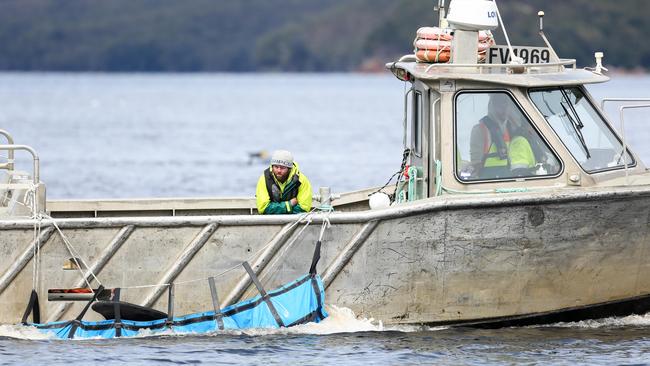
He said the type of rescue operation since Monday had been unique in Tasmania.
“This movement of animals from an offshore location, we haven’t really had to do this with pilot whales before on such a scale,” he said.
“We’re using new and novel methods as part of the rescue.
“We’re getting up to 94 animals released - that is one hell of an effort.”
Most of the rescues involve rescuers in the water in wetsuits bringing the whales alongside boats for them to be towed out through Macquarie Heads to deeper water.
“Each and every stranding is different and you apply the method you have at your disposal to undertake the best, quickest and most humane rescue of animals.”
Dr Carlyon said the best case scenario for the released animals was that they regroup and reform bonds.
“It’s obviously a stressful event and it will take some time, but we’re hoping that will occur.”
Sharks have been sighted in the area with reports of one whale being “chomped”.
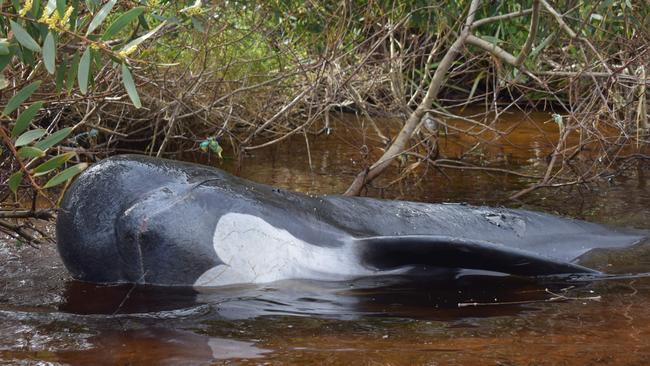
“It needs to be understood that this is an environment that sharks are present in all the time and sharks are certainly not uncommon in this part of the world and in fact the locals fish for sharks off the beach,” Mr Deka said.
“To date we haven’t noted any sharks inside the harbour.
“We don’t think they’ll enter the harbour but we are keeping a very keen eye open for that and if we get any indication that that’s likely to increase in risk, then we’ll reassess how we’re using our people and get them out of the water.”
EARLIER:
METHODS to dispose of the hundreds of pilot whale carcasses in Strahan’s Macquarie Harbour will be trialled on Friday after Mondays mass stranding.
Parks and Wildlife Service regional manager Nic Deka said the main option being explored was towing the dead animals out to sea and slashing their skin before releasing them with hope they bloat and explode before drifting back to shore elsewhere.
The number of dead whales in the harbour remains at about 380 with hopes that number may decline as rescue crews continue to search for living whales among those stranded.
“We have been taking a lot of advise from exerts,” Mr Deka said.
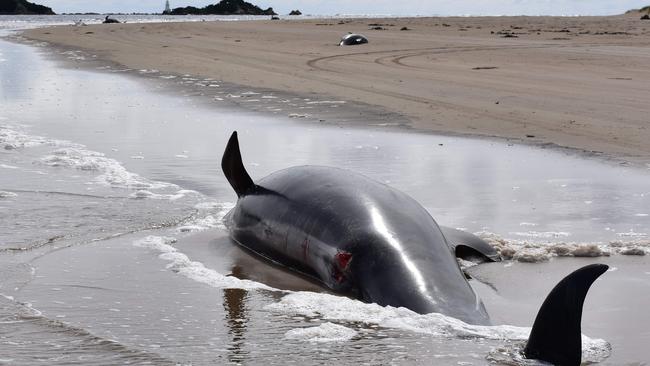
“We’ve had information from CSIRO on currents and we’re also taking advice from the companies that work here – Petuna [Acquaculture], Tassal and Huon [Acquaculture].
“They’ve all been providing fantastic assistance and continue to offer that with the collection and disposal.
“They know the harbour, they know the tides and they certainly have the equipment to assist us.”
Mr Deka said the disposal effort could take “several days”, but it was difficult to estimate as it will be impacted by environmental factors.
The department has commissioned a barge with a crane on board to travel from Devonport to load up the whales and take them to sea, but the best approach is still being devised.
It is expected to arrive on Monday, ready to work on Tuesday.
On Friday morning, Mr Deka told the ABC modelling on ocean currents would help identify the best ocean site to deposit the carcasses so they would disperse without causing problems.
“Before the whales are released out at sea they will be slashed and that sounds quite callous.
“Slashing through the skin to a depth of about 1cm means that the carcass will burst in a relatively short time and when it bursts, the buoyancy goes out of it and so they’re less prone to ending up back on shore.
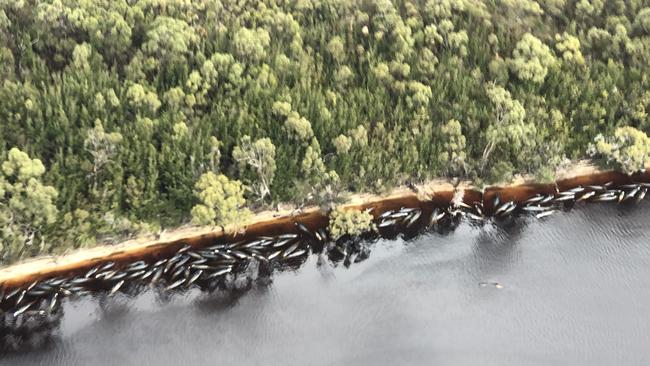
“But if the carcasses do end up back on shore, we’re hoping that will occur in places where they don’t cause problems for stakeholders whether they be the community, the crayfishing industry or whoever.”
Mr Deka said slashing the carcasses will cause decomposition to occur more quickly.
“If a carcass ends up on a beach with wave action and sea life, decomposition will occur relatively quickly.
“It’s likely for several days we’ll keep finding carcasses.”
Parks and Wildlife began trialling methods to contain groups of dead whales on Thursday, including using pens to prevent them drifting about the harbour complicating disposal efforts.
“We’re also considering using weighted buoy line,” Mr Deka said.
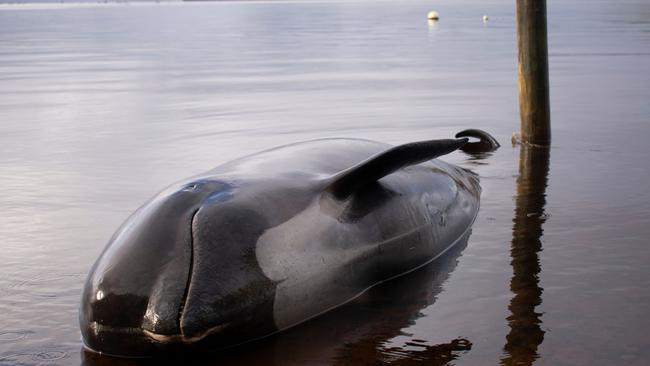
Mr Deka said the dead animals in the harbour could attract other predators such as sharks and also posed environmental and health issues.
“The decomposition of such a large number of animals could actually affect oxygen levels in parts of the harbour, which could affect marine life in those places.”
Gordon River Cruises general manager Geoff Ayers said “hundreds of rotting whales floating about the harbour is not great”.
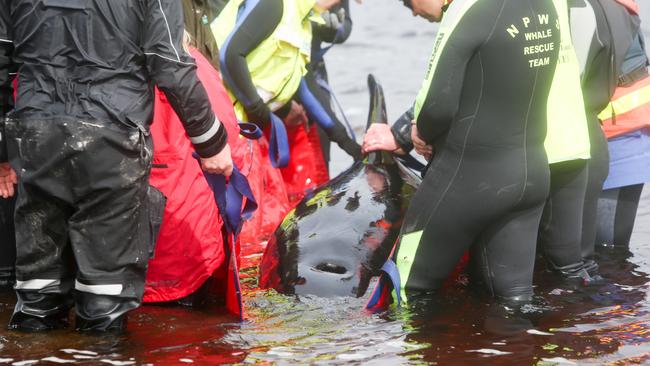
“It will be a difficult task for the parks and wildlife guys to work out exactly what they’re going to do, whether they decide to bury them all or tow them out to sea,” he said.
“Either way it’s a mammoth task.”
Counselling services are available to distressed staff.


